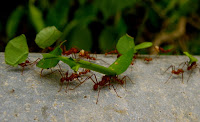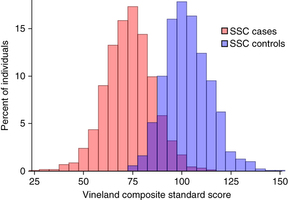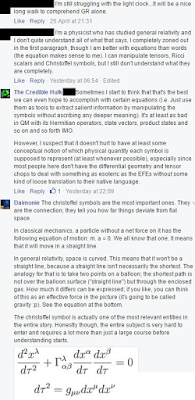A tale of selection
Introduction
While reading my delightful new book - which I will name at the end - I realised how only a small part of people realises all implications of natural selection.
It was Charles Darwin, in the Origin of species (By means of natural selection) that first postulated an explanation of evolution by a one mechanism of heritability and another of variability. We know both mechanisms; they are in our DNA. DNA is the mechanism of heritability, and copying errors and sexual reshuffling are the mechanism of variation.
It was Charles Darwin, in the Origin of species (By means of natural selection) that first postulated an explanation of evolution by a one mechanism of heritability and another of variability. We know both mechanisms; they are in our DNA. DNA is the mechanism of heritability, and copying errors and sexual reshuffling are the mechanism of variation.
Not too long ago, breeding was invented. By this I do not mean merely the breeding of livestock, but the deliberate selection of offspring so as to produce some sort of phenotypical change. The result are the many 'races' of dogs and cats we are familiar with.
The first chapter of the Origin is `variation under domestication', and is essentially about breeding or artificial selection. From there, Charles Darwin leaps onto 'variation under Nature' and natural selection as a mechanism. The rest of the book is essentially an extremely satisfying list of examples, by leading naturalist (expert in natural history) of the day. Anybody that claims there is no evidence for evolution should read the Origin.
Variation under Domestication
 |
| Leaf cutter Ants (source). |
As pointed out in the new book I am reading, domestication isn't necessarily limited to humanity. Indeed, many species of ant practise agriculture and husbandry in their nests, with the prime example of the leaf-cutter ant. The leaf-cutter ant cuts leaves to feed to their fungi farms. The image to the right came with a description: "What a wonderful example of symbiotic relationships.". I disagree; this is a wonderful example of domestication, of farming in the wild.
"Nevertheless", that author might say, "these ants have also radically changed their habits and are very dependent on the fungi farms. Truly, both species have adapted to their cooperation and the correct description is a symbiotic relationship." I might even grant that. Indeed, I would respond, we are in a symbiotic relationship with cattle and crops.
"What nonsense is this", my imaginary friend says, "we have domesticated them, not the other way around". Perhaps, I might say. From their perspective, of course, they have a slave species that provides sustenance (fertiliser, animal feed), protection (pesticides, fences, pastures) and so forth. And what do you think of the evolution of lactose-tolerance? "Even so", she says, " we eat them; we take their young, we determine who reproduces. Clearly, we are dominant and I conclude they are domesticated by us". I agree, I add; that is how humans define domestication. And thus, I conclude leaf-cutter ants have domesticated fungi. "Oh, shut up", she adds, "and make me a sandwich".
Seen in this light, many more examples of domestication suddenly pop into view. For instance, grass is domesticated by grazing animals. This might seem odd, until you realise that grass does better in the presence of these grazing animals. From the grass its point of view, cattle provide the service of killing off competitors, such as saplings. From the cattle's point of view, there is a plant that grows leaves sufficiently fast for grazing. And as time goes by, both reinforce this relationship. But, as we just states, the cows eat the grass and can eat the seeds of grass. The cows are dominant, so they have domesticated grass. Now, isn't that a thought?
Agricultural Revolution
We all should know how it works. From a herd of cows, we breed only the female cows that give a large amount of milk. From their offspring, we select the bulls and again the high-producing females. And so we continue; as the generations go by, our cows are better at giving milk than they were. This is a selection of natural variation in milk-producing capacity that is artificially selected.
Ever since we got a clear picture of that process, we've been breeding. But even before that, our species or genus was a selective pressure for many other species. Consider a nomadic tribe, in a landscape with several other nomadic tribes. Our nomadic tribe is peaceful, and they agree on their tribal lands with the other tribes. Over the years, the tribe develops habits. In the winter, it survives on the edge of a lake, spending the time with fishing and hunting animals coming for water. In the spring, it moves out to the plains, where herds of grazing animals are now breaking up and forming smaller, huntable packs. Then, as summer rises, the plain becomes too hot and the tribe moves up the mountains, past the mountain stream. Here, there is relatively easy hunting in comfort. As autumn comes, the tribe moves back to the plains, to catch the migration of the grazing animals, which move from fertile grounds to wherever they spend the winter.
As the tribe makes it rounds, they gather some plants in the area. A vine with berries is plucked, but the inedible seeds are deposited all around the camp. Certain roots are picked, the thickest grass seeds are eaten, berries plucked. Around the camp, the inedible parts and leftovers are deposited. The tribe moves on. In the cleared space that was the camp, the inedible seeds and leftover roots start to grow again.
The next year, the next cycle. The tribe comes into the area, and finds that the camp of their past year is now full of plants. So, they set up camp close by and set to gathering and hunting. As they walk into their previous camp, they find it is full of edible plants. They gather it, and inedible seeds and leftovers are once again spread around the camp. Each cycle signifies another round of unconscious selection for the lushest berries, the easily found root, full of nutrients and so forth. While otherwise not beneficial for the plant, the rewards are many. Their offspring grows without much competition, is sure to be spatially transported. The new grounds are usually full of nutrients - after all, a tribe of humans just left that area.
And so, at one point, the previous camp is filled with grapes, potatoes, elderberry, cabbage and wheat. Not wholly the varieties we have today, but the first domesticated version. Who knows how the first farm started? Perhaps a young family is left behind because their expected birthing is during the moment the tribe must get to the grazing migration. The tribes leaves them, comes back and finds that the (now larger) family is still there, happily living off the plants of the past camps with a little hunting on the side. Soon, the entire tribe spends part of the cycle farming. And, as they accidentally select the crops, spend a larger part of the cycle farming. Until one day, one tribe of farmers throws a rock at another tribe of farmers and we call it civilisation.
Selection
I'm not sure, but I think the inception of agriculture was before that of animal husbandry. Perhaps a sickly horse or a lost foal hung around the easily-gathered foodstuffs of the early farms. Maybe a kindly disposed human, adult or not, nursed such a foundling to adulthood or healthiness. Either way, animals were domesticated as well.
The capacity of a farm is limited. Aas the animals multiply, you must at some point reduce the herd. Naturally, you choose those animals that are least productive. The skinny bulls, the cows that do not produce the least milk. And lo', you have practised artificial selection. As this continues, presumably simply because of herd size versus farm capacity, each farm prunes the weak and least productive. Sometimes, no doubt, farms traded or gifted part of their livestock. Even so, the domesticated cattle was unconsciously selected towards greater production of human foodstuffs.
As time went on, humans became more and more dependent on agriculture and animal husbandry. The selection of the humans is that the bad farmers died out. So, the human species progressed towards better farmers. In that sense, we are domesticated by our livestock and crops.
I don't know how breeding came to be. I imagine it was something of a reward. This meek stallion that worked so well in my field, he must have time with the mare. For humankind, sex is usually seen as a reward. And with our anthropocentric thinking, the same must be true for our livestock. In this way we started to artificially select and breed our livestock.
The results are out there. At some point, breeding made it into the halls of aristocracy. Usually, this can be a bad influence at first. For instance, in 'Daughter of the Empire' by Raymond Feist, there is this amusing passage between the (new) Lady of the House and her highest clerk. The clerk expresses his confusion that many Houses choose their breeding bulls by looking at certain characteristics that reflect the masculinity of the Lord of the House. The Lady replies that, as she doesn't require reflections of her masculinity, but that he should just breed as he thinks is best.
Even so, the reward-system still holds. And, as feudal strongholds grew, so did their kennels. And dog-breeding started. Eventually, breeding turned into a white-collar hobby. At some point, the question of the transmutation of species arose. And Charles Darwin, a young naturalist, went with the HMS Beagle - already called for an artificially selected breed of dog. And soon, most of the western world knew the principles behind breeding.
Directed Evolution
With that, far stronger breeding methods were developed. Eventually, in the early 20th century, we started to mess with the mechanism of variation. Various things can lead to mutation, and the breeding method called mutagenesis was born.
By whatever method, be it the addition of mutagens or ionizing radiation, scientists were able to directly affect the variation in offspring. Take a large amount of seeds, treat them and see what variation this led to. What improvement there is; the rates of mutation changed so very drastically.
Mind you, it's a real lottery. You have little idea of what you're doing; you are just greatly increasing (perhaps by orders of magnitude) the variability of the resulting offspring and then add regular breeding to get those varieties you were looking for.
Nowadays, a strong movement exists that tells us to "Eat organic" and "Natural". Surely, they would disagree with this practise of radical variation? No, they don't. Instead, mutagenesis is a part of the accepted breeding methods for Organic Agriculture.
Directed Mutation
Suppose you are a young scientist doing genetic research on plants. Specifically, you are looking at the problems surrounding caterpillar damage to soybean crops.
You know that, for example, a specific plant in Northern Europe is especially resistant to caterpillars. This, you find, is because it makes a specific protein that is inedible to caterpillars, and even detected by butterflies and makes them less eager to put their offspring on the plant. The gene sequence is quite simply, really. Let's call it the NOCATERPIE gene sequence. You also find that the NOCATERPIE protein acts through a mechanism that is not even present in humans, and is thus completely safe to eat.
You know that, for example, a specific plant in Northern Europe is especially resistant to caterpillars. This, you find, is because it makes a specific protein that is inedible to caterpillars, and even detected by butterflies and makes them less eager to put their offspring on the plant. The gene sequence is quite simply, really. Let's call it the NOCATERPIE gene sequence. You also find that the NOCATERPIE protein acts through a mechanism that is not even present in humans, and is thus completely safe to eat.
After ten years of studying genetics and its mechanisms, you have learned that is in principle possible to insert a new gene sequence and have it synthesised by the cellular machinery. During your studies you have seen the methods (enzymes/proteases/nucleases) used by cells to cut, read and edit the DNA code. You devise a clever scheme to insert the NOCATERPIE gene sequence into the soybean genome.
In the lab, in a carefully quarantined room, you grow the new plant(s). You test if the protein is present, do PCR to confirm the changes made to the genome. You test the plants within quarantine for caterpillar damage. Forward a few years; after many tests, you have determined the plant is exactly what you aimed for. After passing an extensive review by not only your university, but also the country's ethical research committees, you are allowed to take the plant to the university greenhouse. Again, you test extensively and confirm your expectations. Finally, you are allowed to do a field test and find you've created a soybean variety that is resistant to caterpillars.
That's called genetic engineering. It is the most recent addition to our breeding efforts. The exceedingly clear name in the new book I am reading is: Genetically Engineered Mutations. The author is completely correct in that view; all that is done is genetically engineering a mutation. These mutations, however unlikely, can spontaneously happen in nature.
In the lab, in a carefully quarantined room, you grow the new plant(s). You test if the protein is present, do PCR to confirm the changes made to the genome. You test the plants within quarantine for caterpillar damage. Forward a few years; after many tests, you have determined the plant is exactly what you aimed for. After passing an extensive review by not only your university, but also the country's ethical research committees, you are allowed to take the plant to the university greenhouse. Again, you test extensively and confirm your expectations. Finally, you are allowed to do a field test and find you've created a soybean variety that is resistant to caterpillars.
That's called genetic engineering. It is the most recent addition to our breeding efforts. The exceedingly clear name in the new book I am reading is: Genetically Engineered Mutations. The author is completely correct in that view; all that is done is genetically engineering a mutation. These mutations, however unlikely, can spontaneously happen in nature.
Sure, it is a very direct and guided way of going about variation. Even so, there is nothing ethically wrong with it. The precautionary principle applies just as strongly as it does for 'mere' natural variation, mutagenesis, cross breeding/fertilisation, and so forth. Locations are not an ethical consideration; that it was done in a lab does not make a sufficient justification for ethical condemnation.
The book, by the way, is The Ancestor's Tale and is written by Dr. Richard Dawkins.

